
Park works to ‘bear-proof’ Yosemite Valley
YOSEMITE VALLEY, Calif.— At first glance, you notice a few peculiar things about the Valley in Yosemite National Park.
The trashcans are made of steel, tents are provided with impenetrable lockers and you cannot step into an area of the park without being greeted by conspicuous bright signs with huge warning messages inscribed on them.
The National Park Service (NPS) has undertaken a monumental effort to ensure that Yosemite National Park is bear-proof; that is, that their facilities and visitors are as prepared for interactions with native black bears in the area. With an estimated 500 black bears throughout Yosemite National Park, they are not always a rare sight.
You usually can’t hear them sneaking by and, when they’re sighted, it might be because they smell food nearby. These curious animals, though equipped with an incredibly keen sense of smell that can detect food up to several miles away, are frightened of humans. The NPS states that a black bear can recognize the scent of a human up to 14 hours after he or she has left the area.
And the park rangers at Yosemite want to keep it that way.
“We’re going to try an exercise right now. When I count to three, I want everyone to yell ‘Go bear, go bear, go bear!’” announced Daniel Hewitt, a seasonal Yosemite ranger on a Saturday bear stroll through the valley. “I want you to yell it as if you have just seen a bear!”
Surrounded by awkward, cautious smiles from the visitors on his bear stroll, Hewitt leads the small group on the chant.
|
At right, all tents at Curry Village come with a locker. Below, lockers located near the Pines campgrounds. Next, meadows are a feeding ground for bears because of an abundance of larvae, flowers and berries. Last, Ranger David Hewitt conducts a seasonal bear stroll (Photos by Ramon Galiana). |
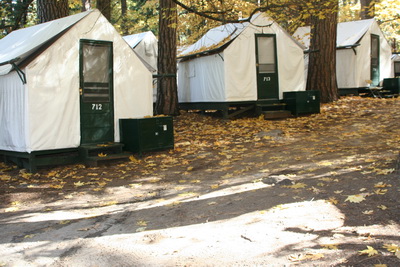 |
What they had yelled was just one tip that the Yosemite rangers ask visitors to follow if they see a black bear; it is vital that it be scared immediately after human interaction. If it continues to fear humans, the tendency the bear will develop aggression towards humans will remain small.
In many ways, the measures the NPS has undertaken to bear-proof Yosemite National Park are as much an attempt to ensure human safety as to preserve the native black bears. Even when backpacking through the wilderness in the Valley, the NPS still recommends that you use bear-proof food canisters and containers. Bears that have gained access to human food have developed to be much less wary of visitors than bears who have been scared in their first encounter with humans.
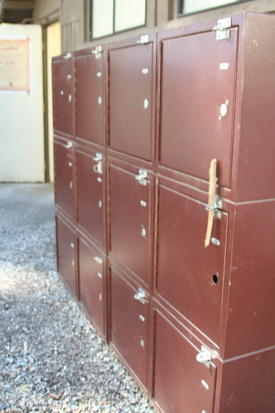 According to park service statistics, the number of bear incidents at Yosemite has already increased by 17.7 percent this year from 2008. Of the total incidents, 73 have occurred in parking lots, causing a total cost of $44,482 of damage to property such as automobiles for careless park visitors.
According to park service statistics, the number of bear incidents at Yosemite has already increased by 17.7 percent this year from 2008. Of the total incidents, 73 have occurred in parking lots, causing a total cost of $44,482 of damage to property such as automobiles for careless park visitors.
A total of $64,085 has already resulted in total damage this year up to Oct. 3. However, the damage caused by these incidents is down six percent from a year ago.
Kari Cobb, a Yosemite park ranger specializing in media relations, has no doubt that these numbers will continue to increase as the year continues.
“We now know that bears particularly like going after minivans in our parking lots,” said Cobb. “The vans tends to have kids – and kids are usually accompanied with a lot of food that stays in these vans overnight. The walls of the van are like tin cans for [black bears].”
Still, the procedures that the NPS has implemented in Yosemite National Park are designed to help the black bear population thrive alongside human visitors.
“One thing I always try to remind people of is that we need to get along with the bears,” Hewitt said. “But part of that is making sure that you follow the rules and not let food in vehicles because they will smell that and just rip through your vehicle. If the bear then becomes aggressive, we’ll have to put it to sleep.”
According to Hewitt, bears that have appeared at campgrounds are considered “problem bears.” By visiting such a popular area, they exhibits a loss of fear in humans, meaning they won’t be scared to destroy property and strike at a potentially aggravating person.
A warning display at the Curry Village parking lot displays a vehicle door that has been bent outward when a bear made his way to delectable items within. Lodge guests in the valley are also given detailed advice about storage of food in their automobiles.
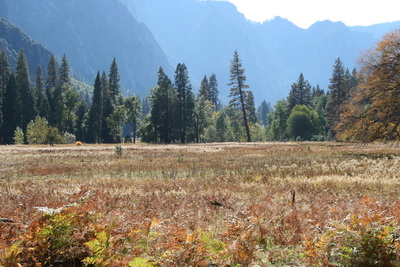 Visitors are asked to store any food products in bear-proof lockers located near the Pines campgrounds and next to rentable tent-cabins at Cutty Village.
Visitors are asked to store any food products in bear-proof lockers located near the Pines campgrounds and next to rentable tent-cabins at Cutty Village.
Waste in bear-proof trashcans are easily accessible throughout the Valley — many of which are marked by the claws of bears that have attempted to break into the containers over the years.
However, black bears have a wide menu from which to select. Incidents in parking lots usually include bears rummaging through hygiene cases to eat toothpaste and soap, particularly because of the distinct flavor and smell these two products carry.
Because they are omnivores, the range of what they eat is widely varied. The meadows in the Yosemite Valley serve as an excellent feeding ground for black bears; if you spot one here, they can usually be found clumsily searching for logs to pry open for its abundance of larvae, as well as picking at a variety of flowers they also enjoy.
Bears are also fond of fruit, particularly small apples, serviceberries, elderberries, and wild cherries.
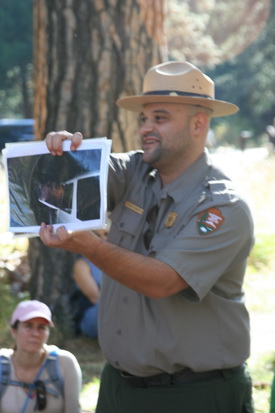 The NPS reports that the availability of human food near the campgrounds is one of the direst threats facing bears today. Their keen sense of smell has certainly put them in precarious situations. Whether its clandestinely making their way through campgrounds or becoming aggressive when spotted by campers, the bear puts itself at risk when it prods into human territory.
The NPS reports that the availability of human food near the campgrounds is one of the direst threats facing bears today. Their keen sense of smell has certainly put them in precarious situations. Whether its clandestinely making their way through campgrounds or becoming aggressive when spotted by campers, the bear puts itself at risk when it prods into human territory.
Preventing the death of these creatures is simple. Visitors must use basic common sense and good practice when visiting Yosemite National Park to ensure bears do not make their way to populous campgrounds, where they will inevitably cause thousands in damage and threaten other campers, and themselves.
Bear Tips for Visitors
When parking your vehicle at Yosemite Valley, always remember to remove all food items from your vehicle.
Use bear-proof lockers near the campgrounds and next to texts at Curry Village for proper storage of scented items that can attract bears.
If you encounter a bear, yell at it. Some rangers have suggested banging pots and pans to scare the bear away. It is important that these animals remain fearful of people.
Do not try to feed, pet, or play with any bear you encounter. They can oftentimes be unpredictable, especially if a cub is nearby.
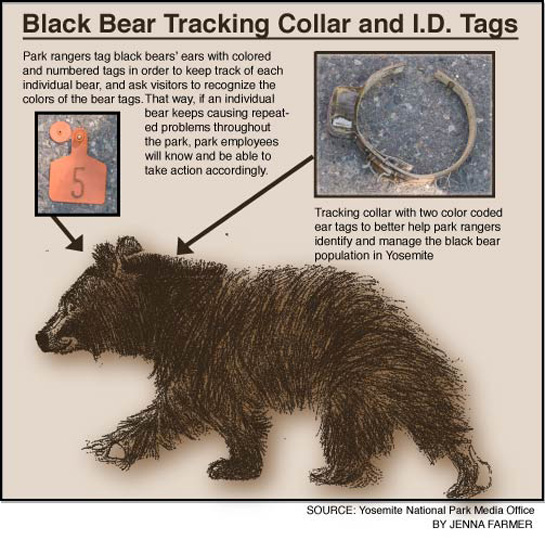
Information graphic designed and prepared by Jenna Farmer.

Comments are Closed